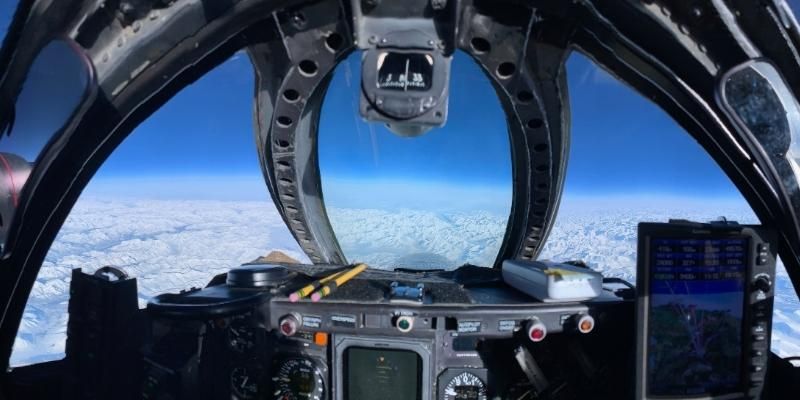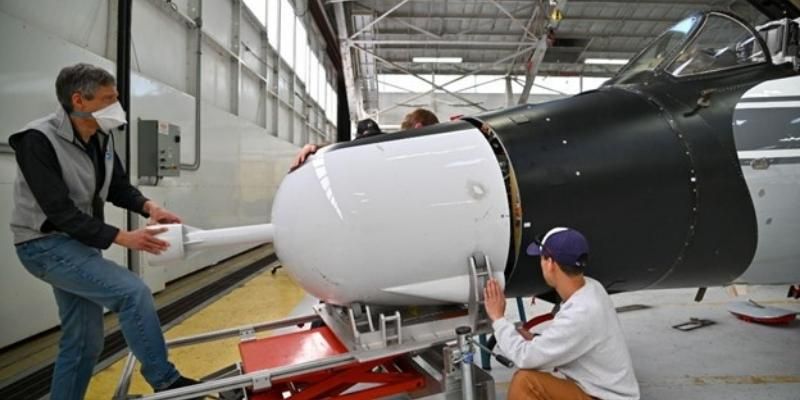
A team of scientists investigating the stratosphere have found particles containing a variety of metals from satellites and spent rocket boosters, vaporised by the intense heat of re-entry.
The particles were found in addition to meteoric ‘space dust’ in the atmosphere, more than seven miles above the Earth’s surface.
The discovery is one of the initial findings from analysis of data collected by a high-altitude research plane over the Arctic during a National Oceanic and Atmospheric Administration (NOAA) Chemical Science Laboratory mission called SABRE (Stratospheric Aerosol processes, Budget and Radiative Effects). It’s the US agency’s most ambitious and intensive effort to date to investigate aerosol particles in the stratosphere, a layer of the atmosphere that moderates Earth’s climate and is home to the protective ozone layer.
This research is so important to help us understand the impact of space exploration on our planet and its climate.
Using an extraordinarily sensitive instrument custom-built at NOAA in Boulder, Colorado, which was mounted in the nose of a NASA WB-57 research aircraft, scientists found aluminium and exotic metals embedded in about 10% of sulfuric acid particles, which comprise the large majority of particles in the stratosphere. They were also able to match the ratio of rare elements they measured to special alloys used in rockets and satellites, confirming their source as metal vaporised from spacecraft reentering Earth’s atmosphere.
The findings were published on October 16 in the Proceedings of the National Academy of Sciences.
John Plane, Professor of Atmospheric Chemistry in the University of Leeds’ School of Chemistry, collaborated on the project, helping to interpret the results.
He said: “This research is so important to help us understand the impact of space exploration on our planet and its climate.
“There are plans for a huge increase in satellite launches - and they are required to fly in low orbits so that they re-enter the atmosphere in two to five years, to prevent the middle space environment around Earth being “clogged up” with spent satellites.
“The result is that the injection of space debris into the atmosphere will increase markedly over the next decade.
“This study demonstrates that the metals produced from the ablation of re-entering space debris are now widespread throughout the lower stratosphere. Furthermore, the amounts of several of these metals - aluminium, lithium and copper – already exceed the natural input from cosmic dust.
“It is therefore urgent that research is now carried out to understand how these metallic species may impact the stratospheric ozone layer and affect the radiative balance in the stratosphere and hence climate – effects that are completely unknown at the present time.”
The SABRE mission focused on aerosols, tiny particles that absorb and reflect the Sun’s rays, shielding the Earth, and that in the right conditions serve as surfaces for ozone-destroying chemical reactions. This discovery by NOAA scientists represents the first time that stratospheric pollution has been unquestionably linked to reentry of space debris.
Mystery of metals
Dr Daniel Murphy, NOAA Chemical Sciences Laboratory research chemist, who led the team which also included scientists from CIRES and Purdue, said: “Two of the most surprising elements we saw in the particles were niobium and hafnium. These are both rare elements that are not expected in the stratosphere. It was a mystery as to where these metals are coming from and how they’re ending up there.”
Niobium and hafnium do not occur as free elements in nature but are refined from mineral ores. They are used in semiconductors and superalloys.
In addition to these two unusual elements, a significant number of particles contained copper, lithium and aluminum at concentrations far exceeding the abundance found in meteorics, or ‘space dust.’
“The combination of aluminum and copper, plus niobium and hafnium, which are used in heat-resistant, high-performance alloys, pointed us to the aerospace industry,’’ Murphy said.
All in all, scientists identified over 20 distinct elements from spacecraft and satellite re-entry in particles sampled during SABRE, including silver, iron, lead, magnesium, titanium, beryllium, chromium, nickel, zinc and lithium.

NOAA scientists install the PALMS instrument in the nose of the NASA WB-57. Credit: NOAA
Particles vaporised
NOAA scientists were able to precisely identify so many different metals thanks to a custom-built instrument called PALMS, short for Particle Analysis by Laser Spectrometry, which ingests and chemically analyses individual particles in the air one by one as the aircraft is in flight. On the WB-57, PALMS is installed into the nose cone of the aircraft with a large forward-facing air intake inlet.
After entering the inlet, an aerosol particle passes through two detecting laser beams that measure its size and speed. A third high-powered laser is then precisely triggered to vaporise the particle. The electrically charged remnants are then swept into two identical mass spectrometers, one for positive ions and one for negative ions. The spectrometers determine the exact atomic mass and relative abundance of each element in the particle, generating a chemical “fingerprint” for each particle.
Pressing questions
Scientists are eager to understand how these particles of aerospace debris interact with other aerosols in the stratosphere because of anticipated increases in space traffic and their potential impact on the ozone layer. They also want to explore the impact of possible future proposals to seed the stratosphere with millions of tons of sulfur aerosols to slow the rate of global warming by reflecting sunlight back to space.
While Dr Murphy and his co-authors estimate that 10% of stratospheric sulfuric acid particles currently contain traces of metals from rockets and satellites, they say that could grow to 50% or more based on the number of satellites being launched into low-earth orbit, and efforts to eliminate space debris at end-of-life by directing it into the atmosphere to burn up.
“There will be a lot of work to understand the implications of these novel metals in the stratosphere,” Dr Murphy said.
As of October 4, the tracking website Orbiting Now lists 8,697 satellites currently in orbit, 7,892 of which are in low Earth orbit and are destined to burn up on reentry.
“At 10%, the current fraction of stratospheric aerosol with metal cores is not large,” said co-author Martin Ross of The Aerospace Corporation. “But over 5,000 satellites have been launched in the past five years. Most of them will come back in the next five, and we need to know how that might further affect stratospheric aerosols.”
Further Information
Picture caption: The view from NASA’s WB-57 cockpit during a SABRE high-altitude research flight. Credit: NASA
For media requests please contact Deb Newman in the University of Leeds press office via d.newman@leeds.ac.uk
Read the research paper, "Metals from spacecraft reentry in stratospheric aerosol particles” published in the Proceedings of the National Academy of Science: https://doi.org/10.1073/pnas.2313374120